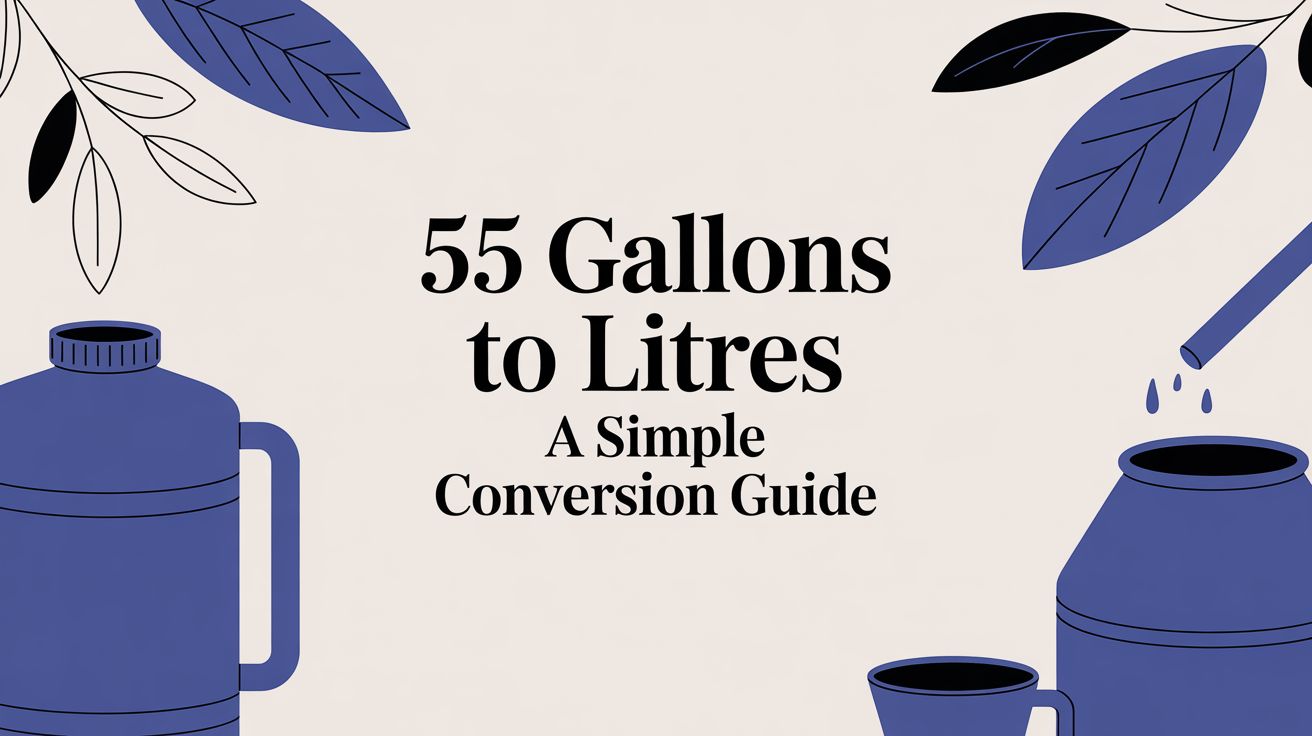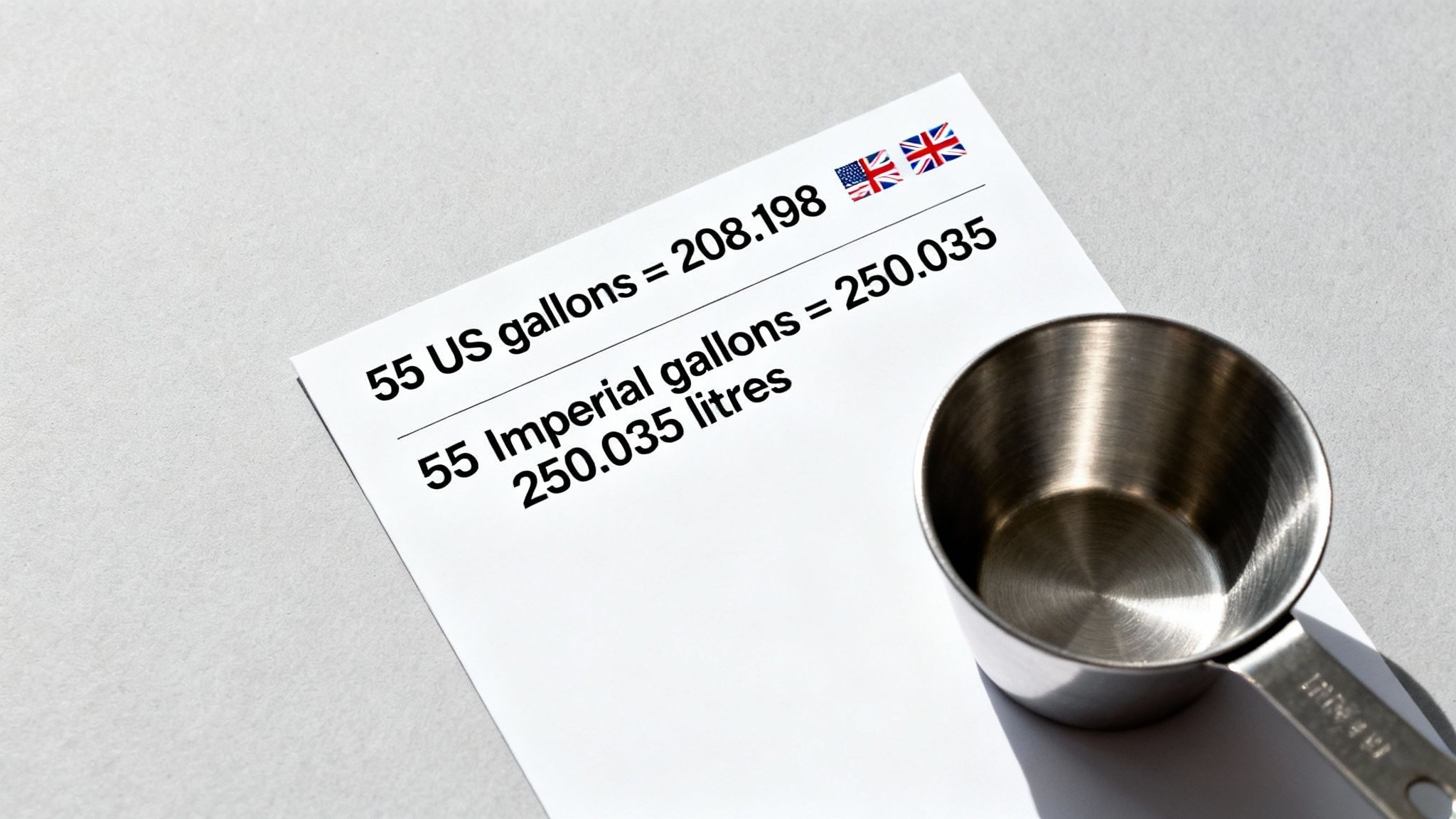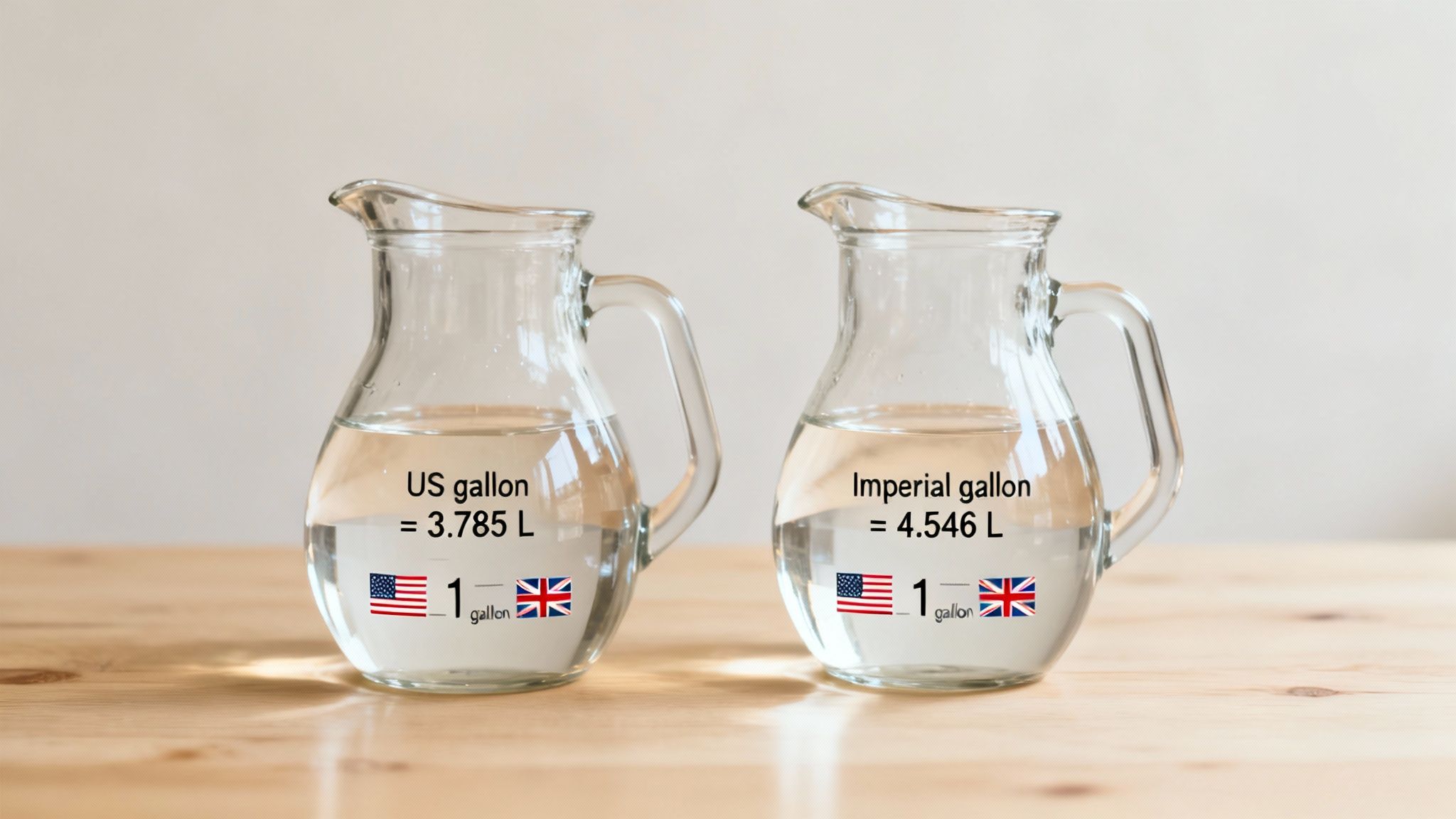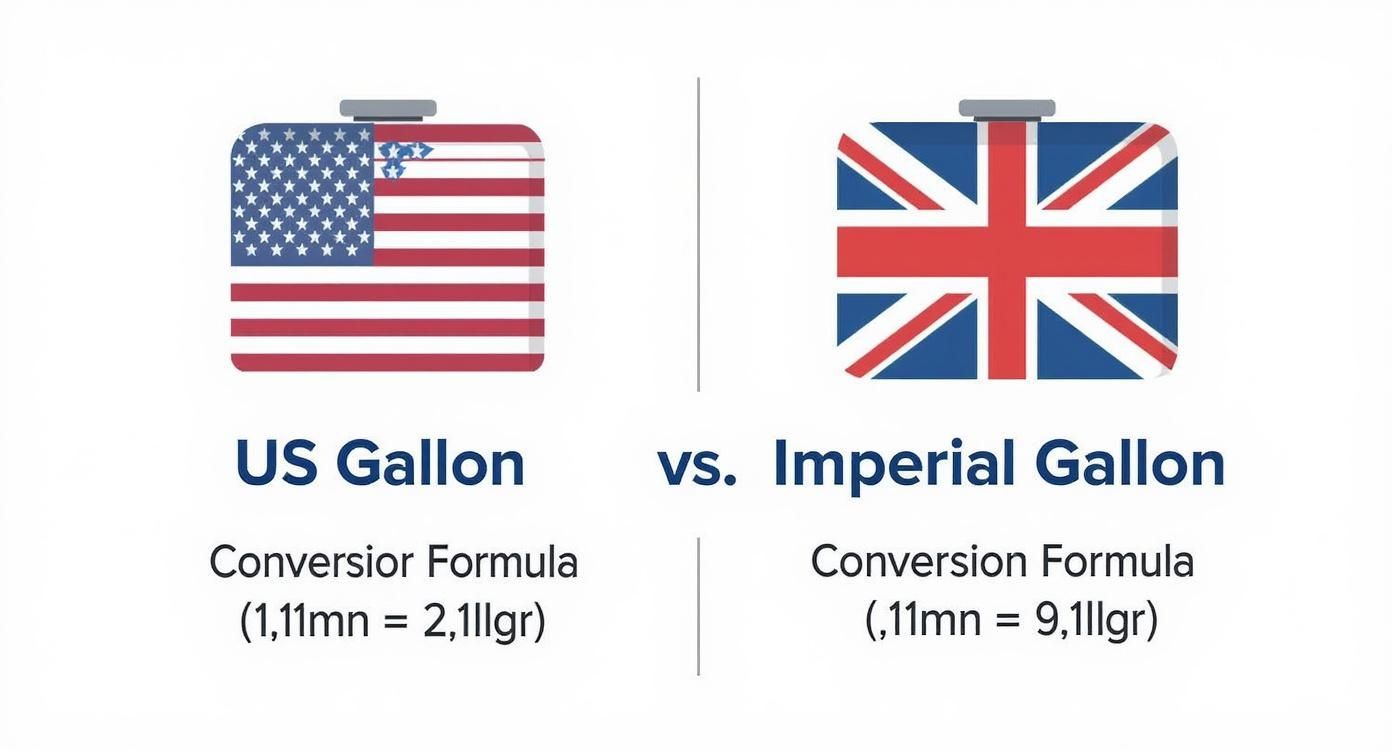Your cart is currently empty!

Written by
in
|
|
|
When you're dealing with bulk liquids, the iconic 55-gallon drum is a familiar sight. But how much is that in litres? The answer depends entirely on which gallon you’re talking about.
For most industrial and commercial uses across North America, the standard is the US gallon. A 55 US gallon drum holds approximately 208.2 litres.
On the other hand, if you're working with the Imperial system (still used in some contexts, particularly in the UK), 55 Imperial gallons works out to a much larger 250.04 litres.
Quickly Convert 55 Gallons to Litres

Before you can get an accurate conversion, the first question you need to ask is: "Am I using US or Imperial gallons?" It’s a crucial distinction, as the two systems are nearly 20% different. Getting it wrong can lead to major issues in everything from chemical mixing to international shipping.
This is especially true for industries that live and breathe by precise volumes. Think about fuel transport, for instance. A standard 55-gallon drum in Canada or the US holds about 208.2 litres. This number is critical for logistics, inventory, and safety compliance. For a deep dive into fuel consumption patterns, the Union of Concerned Scientists offers some great analysis on the scale of gasoline use.
For a simple, at-a-glance reference, here’s a breakdown.
55 Gallons to Litres Quick Conversion
This table lays out the essential numbers you need for converting 55 gallons to litres, depending on the system you're using.
| Gallon Type | Conversion Factor (Litres per Gallon) | 55 Gallons in Litres |
|---|---|---|
| US Gallon | 3.78541 L | 208.20 L |
| Imperial Gallon | 4.54609 L | 250.04 L |
This gives you a quick and reliable answer for both measurement systems.
While the 55-gallon drum is a classic standard, it's not the only size out there. For larger volumes, you'll often see other conversions, which you can read about in our guide to converting 120 gallons to litres.
Understanding the Two Types of Gallons

Before we can even think about converting 55 gallons to litres, we need to tackle a critical question: which type of gallon are we talking about? It's a common stumbling block because, believe it or not, not all gallons are the same size.
Think of it this way: ordering a "pint" in Canada versus the UK gets you a different amount of beer. The same principle applies to gallons. Getting this wrong can throw off your calculations significantly, so let's clear up the confusion between the two main players: the US gallon and the Imperial gallon.
The US Liquid Gallon
This is the gallon you're probably most familiar with if you're in North America. It's the standard for fuel, milk, and most other liquids sold in the United States. A standard 55-gallon drum in Canada or the US is almost always measured in US gallons.
Legally, one US gallon is defined as 231 cubic inches. For our purposes, it's simply the smaller of the two gallons and the one you'll encounter most often in industrial and commercial settings on this side of the Atlantic.
The Imperial Gallon
The Imperial gallon is the heavyweight, coming in about 20% larger than its US cousin. It was the standard across the British Commonwealth and is still used informally in the UK and sometimes in Canada.
An Imperial gallon was originally defined based on the volume of 10 pounds of water at a specific temperature. The history is interesting, but the practical point is much simpler.
The key takeaway is simple: one Imperial gallon holds more liquid than one US gallon. This is why knowing your context is crucial before you even begin to calculate your conversion from 55 gallons to litres.
This isn't just a trivial detail. Imagine ordering a 55-gallon drum from a supplier in the UK versus one in the US. You’d get a lot more product from the UK company, assuming they were using Imperial gallons. For anyone dealing with international trade or precise scientific formulas, mixing these two up can lead to some expensive mistakes. Always double-check which system you're working with.
Doing the Gallon to Litre Math Yourself
While a quick Google search is easy, knowing how to do the conversion yourself is incredibly useful. All it takes is a bit of simple multiplication, and you can figure out volumes on the fly, no matter where you are.
The only tricky part is remembering which gallon you're working with—US or Imperial. Once you've got that sorted, the rest is a breeze. You're just multiplying your gallon measurement by the right conversion number to get the volume in litres. This is especially handy when you need to know exactly how many litres are in a 55-gallon drum.
The Key Formulas
First things first, figure out if you're dealing with US or Imperial gallons. From there, just plug your number into the correct formula.
US Gallons to Litres:
Gallons x 3.78541 = Litres
Imperial Gallons to Litres:
Gallons x 4.54609 = Litres
That's really all there is to it. Here in North America, especially when you're talking about standard industrial containers like drums, you'll almost always be using the US gallon conversion.
A Quick Example: Converting 55 Gallons to Litres
Let's walk through it using our common 55-gallon drum. We'll use the US formula since that's the standard for these containers.
- Start with your gallons: 55
- Multiply by the US conversion number: 55 x 3.78541
- And you get your answer in litres: 208.19755 litres
In the real world, nobody needs that many decimal places, so we just round it off to 208.2 litres. This simple calculation is vital in industries where precise volume is tied to cost, like fuel distribution. For example, as the U.S. Energy Information Administration data shows, pricing for bulk gasoline is directly linked to its litre equivalent.
Once you have these formulas down, you can handle any conversion that comes your way. For more practice, feel free to check out our other gallon to litre guides.
What 55 Gallons Looks Like in Real Life
It’s easy to talk about numbers, but what does 55 gallons actually look like in the real world? The classic image is the standard blue or black industrial drum—a true workhorse in global logistics. These containers are used for shipping everything from food-grade oils and maple syrup to industrial chemicals.
Think of them as the basic building blocks for bulk storage. A standard warehouse pallet can hold four of these drums, creating a neat, stable unit of over 200 gallons that’s easy to move. For anyone who deals with inventory or shipping, knowing the conversion from 55 gallons to litres is absolutely critical for correct labelling, safe handling, and meeting international standards.
Visualizing the Scale of a 55-Gallon Drum
These drums aren't just for industry. They're incredibly popular for home projects, like building a rainwater collection system or a large composter. A single 55-gallon drum holds enough water to fill a big bathtub about two and a half times, or enough fuel to top up the tanks of three or four mid-sized cars. You can find great examples, like this reconditioned 55-gallon plastic drum, used for all sorts of non-potable storage.
To make the difference between the two types of gallons crystal clear, the chart below puts the US and Imperial conversion formulas right next to each other.

As you can see, the Imperial gallon is quite a bit larger. This visual drives home why you always need to confirm which unit you’re working with to avoid costly measurement mistakes.
Comparing 55-Gallon Drums to Other Bulk Containers
While the 55-gallon drum is an industry staple, it's just one piece of the bulk storage puzzle. When you need to scale up, Intermediate Bulk Containers (IBCs) are the next logical step. These larger, cube-shaped totes offer much greater capacity in a single unit.
To help put their sizes into perspective, here’s a quick comparison of the most common bulk storage options.
Comparing Common Bulk Storage Containers
| Container Type | Capacity (US Gallons) | Capacity (Litres) | Equivalent to X 55-Gallon Drums |
|---|---|---|---|
| Standard Drum | 55 Gallons | 208 Litres | 1 |
| Standard IBC Tote | 275 Gallons | 1,041 Litres | 5 |
| Large IBC Tote | 330 Gallons | 1,249 Litres | 6 |
This table makes it obvious how quickly your storage capacity grows when you move from drums to IBCs. A single 275-gallon IBC holds the same volume as five separate drums, which can dramatically simplify logistics and save valuable floor space. For large-scale operations, making the switch from individual drums to IBCs is often a game-changer for efficiency.
Why Accurate Volume Conversions Are So Important

Getting the conversion from gallons to litres right is more than just a math exercise—it’s a critical step with real-world consequences. In any industry dealing with bulk liquids, from food production to chemical transport, precision isn't just nice to have; it's essential.
A small miscalculation can spiral into a massive problem. Think about the safety risks of mixing industrial chemicals in the wrong ratios, or the financial hit from mislabelling thousands of products for an international shipment. These aren't just abstract worries; they are expensive mistakes that can start with one faulty gallon-to-litre conversion.
The High Cost of Small Mistakes
In any commercial operation, accuracy is tied directly to your bottom line and your team's safety. A mistake when converting 55 gallons to litres can mess up everything from a recipe at a beverage plant to compliance with environmental regulations.
- Safety Hazards: Incorrectly measured batches of chemicals, pesticides, or even food additives can trigger dangerous reactions or ruin an entire production run.
- Regulatory Compliance: Product labels have to be exact. Listing the wrong volume can lead to steep fines, rejected shipments, and a serious blow to your company’s reputation.
- Financial Losses: If a bad conversion leads you to overfill containers, you're giving away product for free. Underfill them, and you're short-changing your customers. Either way, you lose money.
Getting the numbers right ensures operational safety, maintains regulatory compliance, and protects your business from unnecessary financial losses. Every decimal point matters when dealing with large volumes.
At the end of the day, whether you're managing warehouse inventory, batching ingredients, or getting a shipment ready, knowing the correct conversion is fundamental. A single 55-gallon drum holds a lot of material, and treating its volume with precision is key to running a professional, safe operation.
Frequently Asked Questions About Volume Conversions
Even with the formulas and calculators, a few tricky questions always seem to pop up when you're switching between gallons and litres. Let's tackle some of the most common ones we hear.
Think of this as a quick-reference guide to handle those finer points, so you can convert any volume with complete confidence.
What Is a US Dry Gallon?
It’s easy to think a gallon is just a gallon, but there's a less common unit you might run into: the US dry gallon. This measurement isn't for liquids; it’s used for things like grain, berries, or other dry goods.
A US dry gallon is about 4.405 litres. That means a 55 US dry gallon container would actually hold around 242.3 litres of material, a pretty big difference from its liquid counterpart. It’s a good reminder to always double-check you're using the right unit for the job.
Does Canada Use US or Imperial Gallons?
This is a classic point of confusion. Officially, Canada is on the metric system, so the litre is the standard for everything sold commercially, from gasoline to milk. You'll always see prices and measurements at the pump in litres.
However, because of our close ties to both the US and the UK, the term "gallon" still gets thrown around. Historically, Canada used the Imperial gallon. Today, if someone mentions a "gallon" without specifying which one, it's best to ask for clarification. But for all official business, the litre is king.
Quick Tip: For rough mental math, you can get a surprisingly close estimate. Since a US gallon is almost 3.8 litres, just think of it as "multiply by 4, then subtract a little bit." It's a great trick for when you don't have a calculator handy.
How Can I Quickly Estimate 55 Gallons to Litres?
Need a fast answer without pulling out your phone? Here's a simple mental shortcut for converting US gallons. Just round the conversion factor (3.785) up to 4 and adjust from there.
- First, multiply your gallons by 4: 55 x 4 = 220.
- Now, you need to subtract a bit. A good estimate is about 5%: 5% of 220 is 11.
- Finally, do the subtraction: 220 – 11 = 209 litres.
This back-of-the-envelope calculation gets you incredibly close to the precise figure of 208.2 litres. It’s perfect for those moments when you need a quick, on-the-spot number.
For all your bulk storage needs, from 55-gallon drums to large IBC totes and all the necessary parts, IBC Tanks Canada has you covered. Explore our full range of products at https://ibctanks.ca.

Leave a Reply